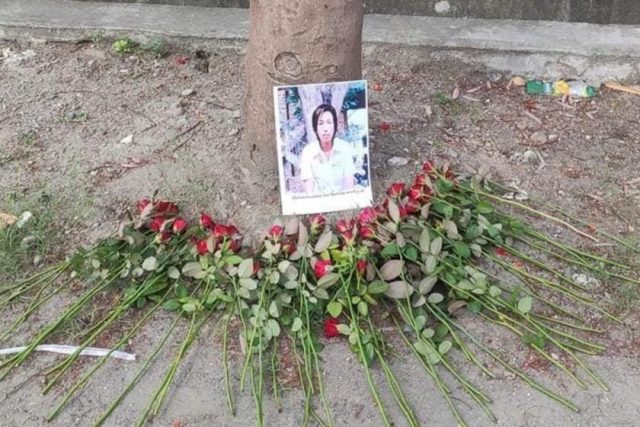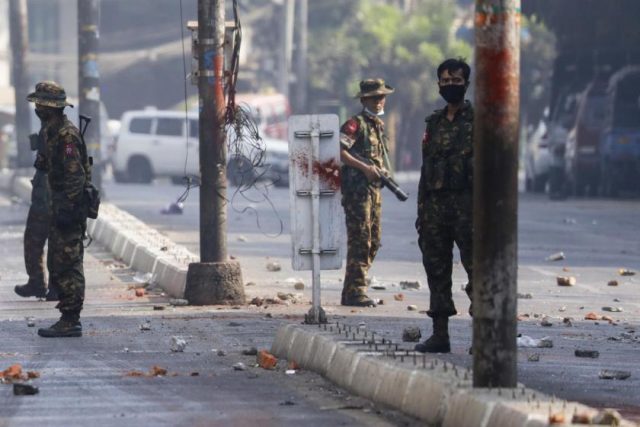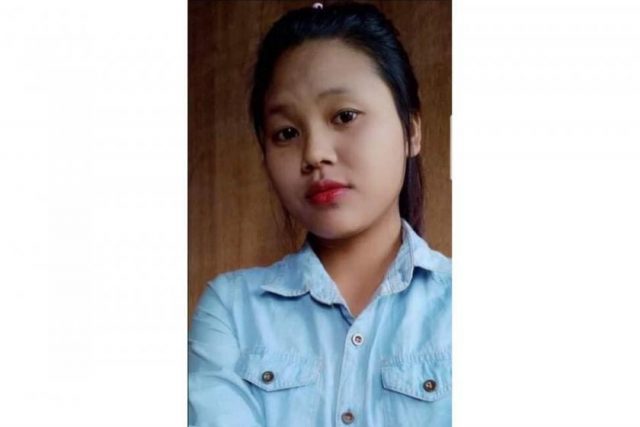Military blames Covid-19 for deaths of detainees during interrogations


A makeshift memorial created by residents of Kalay on June 27 for Salai Van Tha Cung, who died in military custody after being arrested on June 26. The junta blamed his death on Covid-19. (Supplied)
Junta authorities have attributed multiple detainees’ deaths to Covid-19, a designation that loved ones say is a final attempt to cover up the abuse they endured in military custody
By Myanmar Now
Protesters Soe San and Zaw Lin were not home when some 30 junta troops raided their homes in Te Su village, in Mandalay Region’s Wundwin Township, at midnight on June 28.
Unable to locate the men, the soldiers initially arrested Zaw Lin’s wife, then released her.
Maintaining their innocence and fearing the further terrorisation of their families, Soe San and Zaw Lin went to the hospital in the Wundwin Township village of Pindale the following afternoon to meet with the regime authorities stationed there.
“They didn’t do anything wrong, so they decided to meet with them to clear the air so that they would leave their families alone,” a local man from Te Su who was familiar with the arrest told Myanmar Now on the condition of anonymity.
After spending less than one day in the junta’s custody, 44-year-old Soe San, who was also the chair of the National League for Democracy party’s office in Te Su, was declared dead.
“I think they went too far with the interrogation and killed him,” another resident of Te Su village said.
Strangely, the local said, Soe San’s body was presented to his family sealed in plastic—the standard practice for a patient infected with Covid-19, but not a man who had died in police custody.
Soe San’s face was reportedly the only part of his body exposed at the funeral.
He was one of multiple people who have died in military custody since the February 1 coup and whose bodies were later concealed from their families under the junta’s claim that they had Covid-19 and were still contagious. If they could examine the victims, family members of the deceased say they believe their bodies would exhibit clear signs of torture.
“I think they went too far with the interrogation and killed him.”
According to data released by the Assistance Association for Political Prisoners (AAPP) on Wednesday, there have been at least 911 civilians who have died at the hands of the military council since the coup. Of these, at least 30 died in detention.
The military council has repeatedly dismissed the AAPP’s figures as being exaggerated.
No Covid-19 tests are known to have been carried out in the junta’s interrogation centers, which are frequently outside of prisons. Those who have been imprisoned and released since the coup have reported that Covid-19 tests were not carried out in the prisons, either.

The junta’s armed forces are seen in Yangon on March 31 (EPA-EFE)
Interrogation at the hospital, police station
Soe San and Zaw Lin’s families were only notified that the men had been sent to Pindale police station at around midnight, after they had been interrogated at the hospital all afternoon and evening.
Soe San was reportedly sent back to the hospital after passing out at the police station.
The following morning, June 30, Soe San’s family was notified at 11am that he had died.
Their attempts to claim his body were in vain, the first Te Su villager said.
While the military council allowed them to hold a funeral for Soe San at the Wundwin cemetery on the afternoon of July 1, they forbade the family from taking photos of the body or posting about the ceremony on social media.
“They wrapped his body in plastic with just the face exposed. They didn’t directly tell the family that he died of Covid-19, but word got out,” the villager said.
Only 10 family members were allowed to attend the funeral, accompanied by around 30 heavily armed troops, including soldiers from the air force and military engineers.
Zaw Lin, who turned himself in along with Soe San, was released on bail on July 3. Residents of Wundwin said he was severely injured to the point that he was not able to dress himself.
Myanmar Now tried to contact the Pindale police station for comment on the arrests, death and allegations of torture, but the calls went unanswered.

Mai Nuam Za Thiang, a recent high school graduate shot and killed on June 23 (Supplied)
A pattern of deaths
The military’s handling of Soe San’s death was reminiscent of that of 19-year-old Mai Nuam Za Thiang, in Kalay, Sagaing Region on June 23.
She was shot by troops while riding on the back of a motorcycle and died shortly after arriving at the hospital.
“Their post-mortem report said that the girl died of excessive bleeding. However, the body was sealed and returned to us with the claim that she had Covid-19,” a family member of Mai Nuam Za Thiang told Myanmar Now in June.
Again, citing a Covid-19 infection, the military forced her family to cremate her immediately.
“I think they wanted to hide something, so they used that label [of Covid-19]. We could see only the report they gave us, and her face, so we were forced to accept what they said,” her relative said at the time.
“Their post-mortem report said that the girl died of excessive bleeding. However, the body was sealed and returned to us with the claim that she had Covid-19.”
Just two days later on June 26, 26-year-old farmer Salai Van Tha Cung, also known as Zaw Htet, was arrested for unknown reasons at the hostel where he was staying. He died within 24 hours in detention.
Salai Van Tha Cung was cremated immediately, again due to the claim that he was positive for Covid-19, despite showing no symptoms of the virus before his arrest, according to a close relative. The relative added that the victim had not been involved in the anti-coup movement.
Chin State-based media reported that on May 9, a 59-year-old farmer from Haka Township, Pu Tale Lein, was arrested by the military and died after two days in detention. Although a local church asked that his body be returned for burial, the junta authorities told them that he had already been cremated because he had been infected with Covid-19.
One of the earliest known examples of the junta blaming Covid-19 for the death of a detainee was in the case of 26-year-old Yar Zar Aung, who was shot in a crackdown on a protest in Mandalay and then taken into military custody on February 20.
Four days later, his family was informed that he had died in detention, allegedly from Covid-19.
Only four of his family members were allowed to attend his cremation, and from afar.
His wife, Phyu Phyu Win, told Myanmar Now on the day of the funeral that she did not believe Yar Zar Aung’s cause of death was the coronavirus, and felt that he had died as a result of injuries inflicted by the junta.
“We were only able to look at him from a distance, as they said he had died of Covid-19. When we attempted to take his body [from the hospital], they wouldn’t let us,” she said. “I’m upset. I’m not going to let this go.”
Original Post: Myanmar Now

